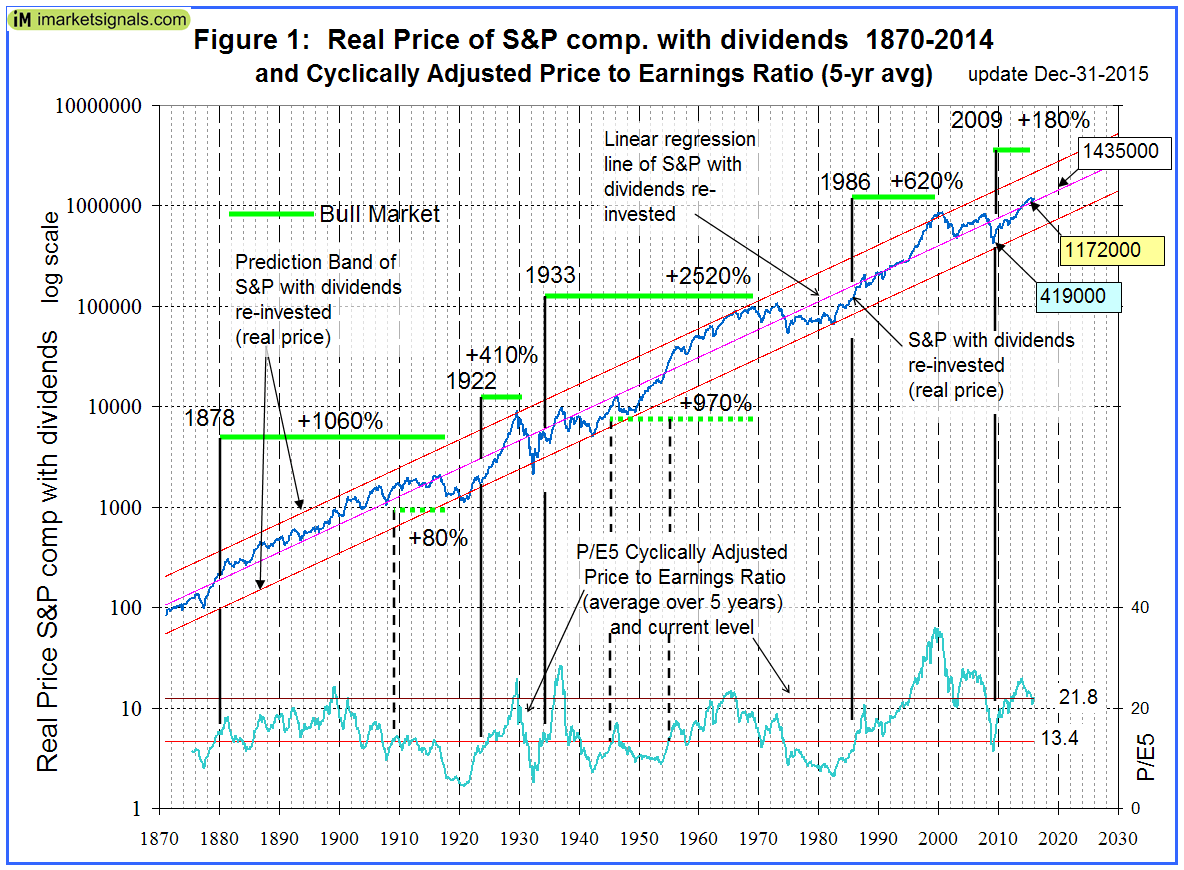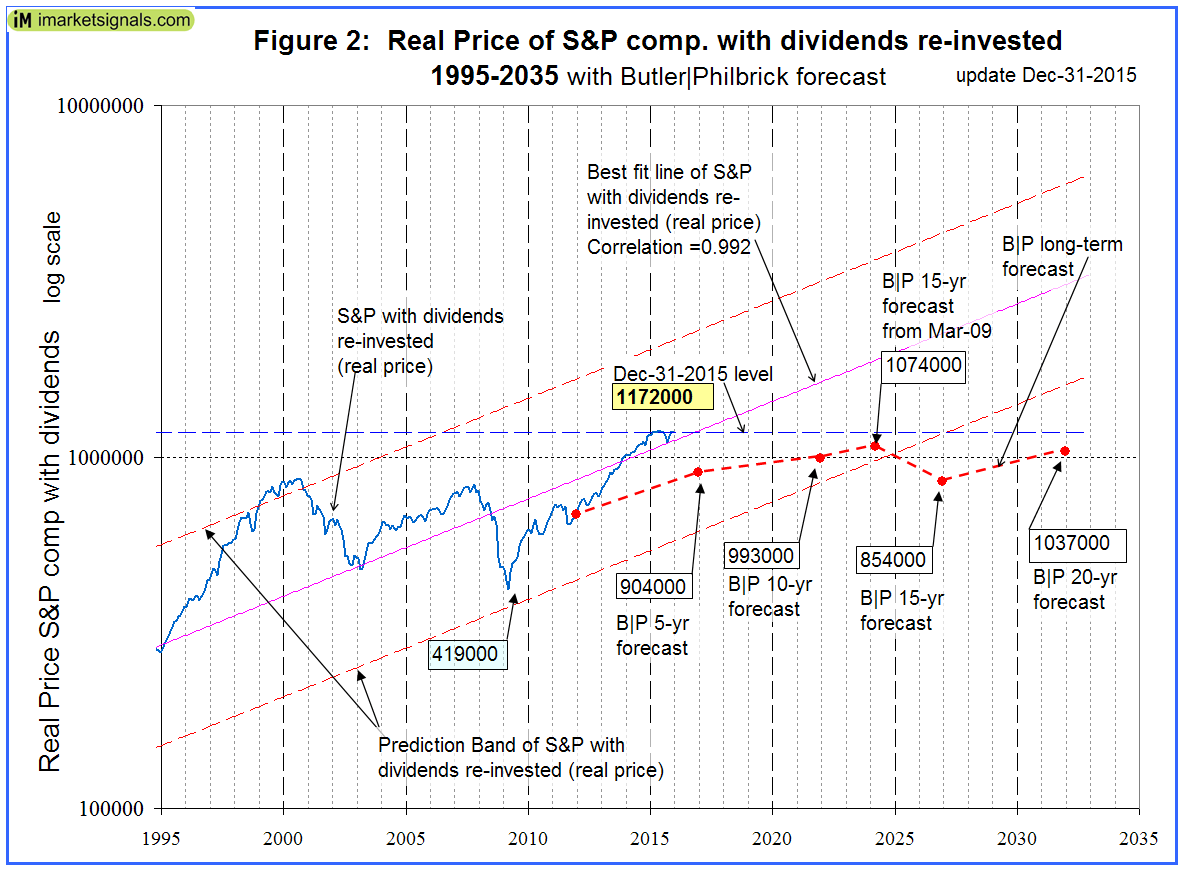Summary
- Based on its historic trend, the stock market appears to be marginally overvalued.
- The historic trend suggests a probable real gain of about 20% over the next five years.
- Analysts’ long-term forecasts of stock returns made 4 years ago appear to have been unrealistically low.
- The Shiller Cyclically Adjusted Price to Earnings Ratio is relatively high (but not extremely high), and a market correction is possible.
About three and a half years ago it was fairly obvious that a major bull market had commenced in 2009 (Appendix A). Also a statistical analysis of the inflation adjusted historic data of the S&P-Composite from 1871 to 2012 indicated the same then. Since August 2012 the S&P500 with dividends has gained a real 52%. So what further gains can we expect, if any?
Will the bull market continue?
Nobody knows, and the best we can do is to use the historic data (which is from Shiller’s S&P series) to guide us to make estimates for the future. From the real price of the S&P-Composite with dividends re-invested (S&P-real) one finds that the best fit line from 1871 onward is a straight line when plotted to a semi-log scale. There is no reason to believe that this long-term trend of S&P-real will be interrupted. S&P-real and the best fit line together with its 95% prediction bands are shown in Figure-1, updated to December 2015. (See appendix B for the equations.)
Also shown is the Cyclically Adjusted Price to Earnings Ratio P/E5 (which is the S&P-real divided by the average of the real earnings over the preceding 5 years). P/E5 has declined from the Jan-2014 peak, and is currently at a level of 21.8.
One observes that whenever S&P-real “bounced-off” the lower extreme of the prediction band, and subsequently P/E5 moved from below to above 13.4 a bull market always followed. The last time this occurred was in March 2009. Since then S&P-real has “only” gained about 180%. Comparing this to previous post-bounce-off-gains (which ranged from 410% to 2520%) then the possibility exists of further gains to come.
What gains (if any) can we expect?
Extending the best fit line and the prediction bands to 2020 enables us to estimate the change of S&P-real from the current level of about 1,172,000. In 2020, the value of S&P-real as indicated by the best fit line should be about 1,435,000, while the highest and lowest values shown by the prediction band would be 2,771,000 and 743,000, respectively.
Thus the historic trend forecasts a probable gain of about 20% for S&P-real to Jan-2020. The worst scenario would be a possible loss of about 35%, and the best outcome would be a 135% gain from the current level.
What other analysts expected
Widely followed commentators, such as Butler Philbrick & Associates (B|P) and Hussman warned us at the end of 2011 that the markets then were expensive and overbought, and that one could only expect very low returns going forward over periods as long as 20 years. Their statistical analyses asserted a very high probability of low returns to stocks in the future. Figure-2 shows the current situation in more detail and also includes the levels of the S&P-real as per (B|P) forecast, indicated by the red markers connected by the dashed red line.
From December 2011 onward B|P predicted a real annual return for the stock market of only 1.46% for 15 years, and 2.08% for 20 years (Table-1 in their article and Appendix C below). Also they forecasted a 6.48% annual return from Mar-2009 to Mar-2024 (Table 2 in their article). One can see that the March 2024 level is quite possible as it is just above the lower extreme of the prediction band, but it would appear that the December 2026 and 2031 forecasts are overly pessimistic.
One will only know at the end of the various forecast periods whether the analyst’s predictions hold up. In one year we will know whether B|P’s 5-year forecast was correct; if so, then the S&P-real will have to lose about 23% from its current level, a decline that is not impossible.
For the December 2031 forecast value to be correct the S&P-real would have to decline by 12% over the next 16 years. There were only two previous periods since 1871 when S&P-real had a negative return over 16 years. These were the periods from 1905 to 1921 and from 1966 to 1982. During the recent period yields of the 10-year Treasuries increased from about 4% to 15% and the Consumer Price Index tripled from 32 to 98, increasing at a 7% average annualized rate. However, without inflation adjustment the S&P with dividends actually increased by about 130% over the same period. So unless we experience very high inflation over the next 16 years it is unlikely that this forecast will be realized.
One can see from Figure-2 that the current level of SP-real is already significantly higher than all the forecast levels from B|P. Also in Hussman’s December 2011 commentary “Hard Negative” he estimated “that the S&P 500 is likely to achieve an average total return over the coming decade of about 4.8% annually”. This would have put the S&P 500 at 2,072 by the end of 2021. Currently the S&P 500 is near this 10 year forecast level, and would have to show no further gains to Dec-2021 for this forecast to be correct.
Is the market overvalued?
One observes from Figure-1 that presently S&P-real is near where it should historically be; its level is just above the long-time trend line.
The P/E5 is at a high level of 21.8 but it is lower than the Jan-2014 peak level. The relatively high level may indicate an overvalued market, with the graph of P/E5 having a downward slope while the market has had a rising trend since 2009.
Similar conditions prevailed only 4-times in the past: in 1929, 1937, 2003 and 2008. Only after one occasion, in 2003, was it followed by a significant market advance. However, at that time the S&P-real had been declining already for several years from the upper extreme of its prediction band. At all the three other occasions the S&P-real had previously peaked, and the market continued to decline for several years thereafter.
Long-term investors should also heed Shiller’s Dec-2013 warning, and consider the high level of the Shiller P/E10 ratio, currently at about 25.9. He states that the plot of P/E10 “confirms that ……Long-term investors would be well advised, individually, to lower their exposure to the stock market when it is high, ….., and get into the market when it is low.” The plot shows that for a P/E10 of 25 one can expect a 10-year annualized return of between -5% and +5%. So caution is certainly indicated with the P/E10 at a level of about 26, but positive stock market returns are still possible over the next 10 years.
Conclusion
The current relatively high P/E5 and P/E10 levels suggest moderate longer-term returns. One should consider low frequency market-timing models to protect one’s investments. Also during down-market periods low volatility stocks should decline less than the broader market, and therefore could provide exposure to the stock market with potentially less risk. It is also important to know when a recession is looming, as stocks usually decline during recession periods.
Appendix A
Previous articles in support of a bull market:
1. Estimating Stock Market Returns to 2020 and Beyond (Advisor Perspectives, 8-20-2012)
2. Is the Next Great Bull Market Already Here? (Advisor Perspectives, 8-14-2012)
3. Get Ready for the Next Great Bull Market (Advisor Perspectives, 8-9-2012)
4. Anticipating the Ultimate Death Cross (Advisor Perspectives, 7-24-2012)
5. The Ultimate Death Cross – False Harbinger of Doom (Advisor Perspectives, 7-24-2012)
Appendix B
The best fit line and prediction band were calculated using statistical software from PSI-Plot. There were 1699 data points from Jan-1871 to July-2012. The SP-real values for the period after July-2012 are “out of sample” and were not included in the regression analysis.
The equation of the best fit line is y = 10(ax+b) .
y = is the dependent variable of the best fit line.
x = are the number of months from January 1871 onwards.
a = 0.0023112648
b = 2.02423522
The Pearson correlation coefficient is 0.992. This number is most appropriately applied to linear regression as an indication of how closely the two variables approximate a linear relationship to each other. A perfect fit would have a correlation coefficient of 1.000.
The equation of the upper and lower extremes of the prediction band is y = 10(ax+b)
with parameters ‘y’, ‘x’, and ‘a’ as before, but with
b = 2.31005634 for the upper extreme line, and
b = 1.73841411 for the lower extreme line of the prediction band.
Appendix C
Butler|Philbrick real returns forecast for the stock market from December 2011.
Estimating Future Stock Market Returns, Butler Philbrick & Associates
(Advisor Perspectives, December 14, 2011)




Anton,
I seem to remember that previous article on long-term expected return looked at a moving average for Shiller P\E 5 or 10. Using a moverage average regression indicated that the current level of cyclically adjusted 5 or 10 year earnings is not as elevated relative to current readings. Why did you take out that information? Is the previous article available on your website?
Steve
All previous articles can be found here: https://imarketsignals.com/tag/2020/
We did not repeat the 35-yr MA of P/E5 because there was not much interest expressed in this method.
Hi. Interesting. To me that 35-yr moving average of P\E5 was the key insight into whether the market was significantly overvalued or not. It suggested to me that in a low interest rate\low inflation economy that market participants were adjusting what is a reasonable P\E to a higher level as opposed to Hussman B\P and others who used a static analysis and concluded that a 25 P\E5 was a sign of siginficant overvaluation and did not make any adjustment to account for today’s low benchmark rate conditions. Thanks!
Steve
I, for one, would like to see updates to the 35-yr moving average analysis each time you update the “Estimating Returns to 2020 and Beyond” post.
Thanks.